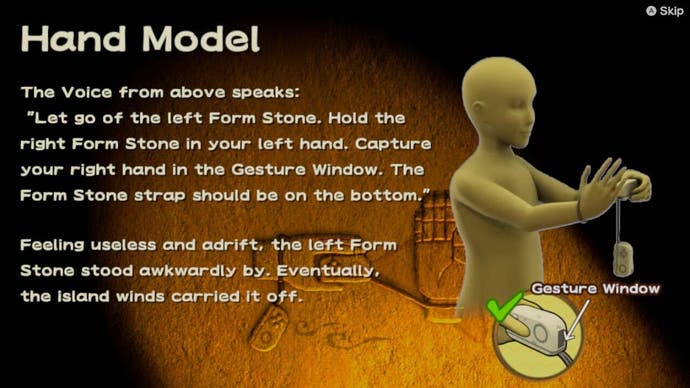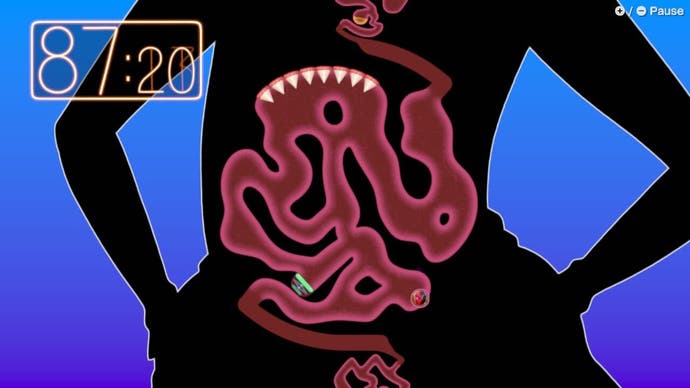WarioWare: Move It! review - motion controls make for messy microgame management
Exercise patience.
I have three seconds to open these cupboard drawers, but as soon as they appear I know I'm toast. I stand (and with WarioWare: Move It! you really do need to stand) with arms outstretched. My fists are clenched, and I have correctly assumed the game's "Choo Choo" position - like I'm going to mime the movement of a chuffing steam train. My body is ready. But as I rapidly yank my fists towards me, again and again until the time runs out, the drawers stay put. And this, sadly, happens relatively often.
Move It! is Nintendo's latest collection of typically excellent and extremely bizarre microgame ideas, served at breakneck speed. As always, you have only seconds to work out what is going on, what you're being asked to do next, and then react to actually do the thing yourself. But, this time around, all the microgames require motion controls - and this is something I ultimately found to be more of a burden than a blessing.
When I think of the best motion-controlled games, I think of the one I still play with friends every now and again - Wii Sports. It was an enormous success because its motion controls encouraged participation. The gestures were completely self-explanatory. There were no fiddly buttons to learn, even on the simple Wii Remote. Everyone knew how to hold the controller as a tennis racket, or shift to a different position when using it as a golf club.
Some of this does carry through to Move It!, and some of my friends who tried it (who might otherwise have struggled quickly finding the right Joy-Con buttons) could easily snap their arms open and shut to make a crocodile gobble fruit, or flap their arms up and down to help a straining chicken squeeze out an oversized egg. And, of course, watching your fellow players' frantic gestures certainly adds to the experience, amping up the comedic value of a series full of oddball humour, and which has been all-in as a multiplayer affair since its GameCube iteration.
The difficulty here is two-fold: the need to regularly change starting positions before each microgame begins - with a large number of possible poses and a couple of really fiddly stances in particular - and the fact that the motion gestures sometimes aren't reliable enough, or forgiving enough, for players who'd otherwise benefit from using motion controls to properly keep up. The results can instead spark frustration at the need for motion controls at all, and fuel a sense of unfairness when playing competitively.

The WarioWare series' frantic pace is kept from previous games, and arguably feels even more hectic here with the need to learn and quickly assume 18 poses from which microgames can begin. In Story Mode, these poses are explained in brief and humorous tutorials as you begin unlocking Move It's bulging catalogue of over 200 bitesize microgames. But in multiplayer, it's assumed everyone knows what they're doing, and can always follow the on-screen prompt before the next game begins. It's a shame there's no catchup option or, even better, simply fewer stances to begin with.
Two stances in particular require extra work, one where you drop the Joy-Con out of your hands (with wrist straps attached, obviously) to simulate the release of an item on screen (such as feeding grain to a bird, or dunking food in a deep fat fryer). The other is a stance that involves the right Joy-Con's little-used IR sensor, which must be held and angled in your

And then there's a few microgames where the controls don't seem to reliably function - or where performing the motion you know you need to do to win becomes the sticking point. Examples of these are those aforementioned cupboard drawers, or another microgame where you must accurately peck downwards at a worm but where you always seem to veer off-course. There are other examples, too: a game where you have to pass a bomb between your legs, and another where you have to pump your arms a
As always, each microgame hides further layers - different variants brought on by chance or additional difficulty levels - meaning that the 200+ games feel far more numerous when trying to remember what you need to do, and remain fresh even after being seen multiple times before. One example of this is a microgame where you must help a mouse escape a trap, while a hungry cat looks on. In the microgame's first level, you can simply avoid the cat's gaze. In its second level, you must ring a bell to distract the cat before freeing the mouse. In a third level, there's no bell - your timing with the cat must instead be exact. At breakneck speed and with the response to one variant already in your muscle memory, it makes for a frenzied experience to keep on top of.

It's tough to describe Move It's microgames and properly capture their spirit. They remain mostly brilliant, each a little germ of an idea with its own feel, with varied art styles and bags of character. Even the most simple - pulling your hands apart to force open a set of prison bars, for example - is kept a surprise by the game providing a slew of alternate outcomes: scenes for where you escape to (including sometimes, I've spotted, some dingy toilets). And for long-term fans of the series, there's no end to the Easter eggs featuring past characters and previous microgames (Pyoro! Fronk!).
Some of the game's best microgames are the longer boss levels, which can sometimes stretch several minutes. With a bit of space to breathe and no need to quickly change positions, these feel a far fairer exploration of motion controls, with some great examples: a hectic attempt to keep a flame alight while water pours down from various positions above, and another game where you tilt a poison apple back and forth, navigating it through Cinderella's guts and out of her anus. WarioWare: Smooth Moves' catchy Super Wario Dance Company is a Just Dance number in disguise, while in the retro Nintendo suite of levels, there's a motion-controlled version of Super Mario 64's Princess Peach's Slide. Brilliant. Another smart addition is a single-player mode which selects Move It's most energetic microgames, and gives you a kind of calorie burning score for how much you worked out. It'll keep you warm as we all avoid putting the heating on.

Move It has a vast swathe of multiplayer options for up to four people - most of which deserve a play, though some are better than others. Galactic Conquest places players on a Mario Party-style board game, with some ridiculous spaces that regularly see play reversed and people swap places. Medusa March places you in a game of Red Light Green Light, with microgame success helping you on your way to victory as you avoid being spotted and turned to stone. Listen to the Doctor takes the action outside of the game, and asks your fellow players to watch as you perform silly gestures or say ridiculous things while playing the next microgame - then award points based on your performance.
But still, these do not escape the issues mentioned previously and, one multiplayer game Nintendo lists separately on the main menu to advertise its prominence is particularly prone. Copycat Mirror asks one person to "play" microgames without holding any controllers, while a partner faces them instead of the TV screen and copies their movements. It's a smart idea, with the partner's movements ultimately counting for passes or failures, though it's one where the game's motion controls feel like they should be a little more forgiving, as they translate the movements you're attempting to copy.
WarioWare has frequently experimented with alternate control schemes or other microgame gimmicks - Smooth Moves was another motion controlled affair, back on the Wii - and, more than 10 games into the series, it's impressive the microgames themselves feel as fresh as ever. But in leaning so heavily into motion controls to accomplish that fresh feeling, Move It acts as an obstacle to the party game audience it also seeks to attract - in short, undermining its own gesture.
A copy of WarioWare: Move It! was provided for review by Nintendo.


